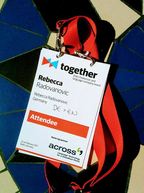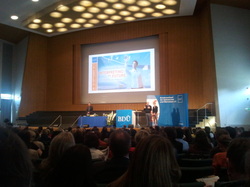After attending the SDL Trados Roadshow in Munich last week and chatting to some of the other attendees, I once again found myself pondering the life of the translator, especially that of the freelancer. Ever since deciding to work as a freelancer as opposed to working for an employer and physically sitting alongside colleagues, I’ve made a conscious effort to stay sociable as a translator. The job of any freelancer can be a lonely one, which makes securing and maintaining connections within the industry even more meaningful. This could be by attending local translator meet-ups, conferences or client events, by joining and actively contributing towards industry-specific groups and associations, or simply by having a good rapport with clients and fellow translators online, in person, or over the phone. It is this last point in particular that I fear we are losing, or at least being encouraged to dispense with, for the sake of increased efficiency.
It’s nothing new that life is becoming more and more automated. The pace is picking up, especially in the business world, where there is a growing expectation for immediate solutions to problems and increasing impatience if these solutions are not delivered pronto. In the translation industry, I feel day-to-day processes are being accelerated by two means. The most obvious, though not the focus of this blog post, is through the increasing incorporation of machine translation and the gradual shift, in some areas more than others, from translator to post-editor. The argument here being that less time is required for translation proper, resulting in increased productivity – quantitatively speaking at least – and thus greater translation capacity. If the translation itself is the product then the second means relates more to the packaging or, more specifically, the reduction thereof; the desire by some to streamline the overall translation process, whether in terms of preparing quotes, sending out requests or uploading files.
At one of the talks back at the Elia conference in February, I actually found myself fascinated by the way in which one speaker – a translator and agency owner – had embraced automation at his company, for instance by incorporating an automated quoting system. Rather than having to email to and fro, a platform had been developed allowing clients to simply upload their texts, indicate the specialist area, and immediately receive a quote. The same day I went for dinner with a fellow attendee who was telling me about an automated process he used to allocate suitable translators from a large pool of subject areas and language combinations to jobs that would come in over a similar system. For the sake of staying on topic, let’s assume that both these approaches to automation work like a dream. While this is all well and good in terms of a quick turnaround, and as much as I’m open to new technologies, a big part of me fears we’re losing the human side of what we do.
I imagine most of us who work in this industry, regardless of in what capacity, chose to work in it first and foremost because of our simple love of languages. With this comes an appreciation of different cultures, perhaps a keen urge to travel, to discover new places and new people, to converse and, insofar as possible, to communicate across borders and barriers. For me at least, that is the essence of why I do what I do. That and I like to talk. A lot. How sad then if in order to do our job – in order to facilitate communication – we are being asked to accept the opposite and have our own communication channels cut down.
It’s for all the above reasons that I hope we aren’t starting to witness the demise of our tongues beyond the products we deliver. It would appear that at some point the road pursued by the LSP splits into two. The first path seeks to drive forward the trend towards greater automation and less human communication in the hope for heightened productivity. It gets you from A to B precisely as the crow flies. Then there’s the other option, a second path that equally gets you from A to B but meanders slightly. It comes with a mountain backdrop and the twittering of birds. Both paths start and end in the same places, you simply have to decide whether you want to turn your trip into a more rounded experience or whether you’re happy to arrive at your destination aware of little more than the number of miles you’ve covered.
I’m a big believer in building and maintaining respectful client relationships. From taking the time to look at a text a client has not only created but also deemed important enough to warrant a translation, to deciding – from an LSP perspective – which translator would be the best fit for the assignment. And not just because they were the first to respond to an automated job request for a “medical” or “legal” text. I love to work with people who ask how I am, how my weekend was and whether Munich has had any snow yet. And they actually want to hear my response! They appreciate what I do just as much as I value them as my colleagues. They make long days at the desk that little bit brighter and more sociable.
By all means, every single one of us should be embracing, or at the very least experimenting with and developing our own opinions on, the latest technologies out there. I’m not advocating that we collectively shake our heads at technological advancement, neither in terms of MT nor process automation. However, I certainly hope that the rise in this kind of technology does not imply a breakdown in human contact. It’s one thing to work with a machine, but it’s another thing entirely to be treated like one. I’m sure there are clients out there who place emphasis on speed and convenience when choosing an LSP, who simply want to get the job done. But I believe there are just as many, if not more, who like to be more involved in the translation process and want to know who they are working with. No matter what side of the fence you find yourself leaning towards, I urge all of us not to lose touch with the human side of our work and not to forget what made us so passionate about our profession in the first place.
It’s nothing new that life is becoming more and more automated. The pace is picking up, especially in the business world, where there is a growing expectation for immediate solutions to problems and increasing impatience if these solutions are not delivered pronto. In the translation industry, I feel day-to-day processes are being accelerated by two means. The most obvious, though not the focus of this blog post, is through the increasing incorporation of machine translation and the gradual shift, in some areas more than others, from translator to post-editor. The argument here being that less time is required for translation proper, resulting in increased productivity – quantitatively speaking at least – and thus greater translation capacity. If the translation itself is the product then the second means relates more to the packaging or, more specifically, the reduction thereof; the desire by some to streamline the overall translation process, whether in terms of preparing quotes, sending out requests or uploading files.
At one of the talks back at the Elia conference in February, I actually found myself fascinated by the way in which one speaker – a translator and agency owner – had embraced automation at his company, for instance by incorporating an automated quoting system. Rather than having to email to and fro, a platform had been developed allowing clients to simply upload their texts, indicate the specialist area, and immediately receive a quote. The same day I went for dinner with a fellow attendee who was telling me about an automated process he used to allocate suitable translators from a large pool of subject areas and language combinations to jobs that would come in over a similar system. For the sake of staying on topic, let’s assume that both these approaches to automation work like a dream. While this is all well and good in terms of a quick turnaround, and as much as I’m open to new technologies, a big part of me fears we’re losing the human side of what we do.
I imagine most of us who work in this industry, regardless of in what capacity, chose to work in it first and foremost because of our simple love of languages. With this comes an appreciation of different cultures, perhaps a keen urge to travel, to discover new places and new people, to converse and, insofar as possible, to communicate across borders and barriers. For me at least, that is the essence of why I do what I do. That and I like to talk. A lot. How sad then if in order to do our job – in order to facilitate communication – we are being asked to accept the opposite and have our own communication channels cut down.
It’s for all the above reasons that I hope we aren’t starting to witness the demise of our tongues beyond the products we deliver. It would appear that at some point the road pursued by the LSP splits into two. The first path seeks to drive forward the trend towards greater automation and less human communication in the hope for heightened productivity. It gets you from A to B precisely as the crow flies. Then there’s the other option, a second path that equally gets you from A to B but meanders slightly. It comes with a mountain backdrop and the twittering of birds. Both paths start and end in the same places, you simply have to decide whether you want to turn your trip into a more rounded experience or whether you’re happy to arrive at your destination aware of little more than the number of miles you’ve covered.
I’m a big believer in building and maintaining respectful client relationships. From taking the time to look at a text a client has not only created but also deemed important enough to warrant a translation, to deciding – from an LSP perspective – which translator would be the best fit for the assignment. And not just because they were the first to respond to an automated job request for a “medical” or “legal” text. I love to work with people who ask how I am, how my weekend was and whether Munich has had any snow yet. And they actually want to hear my response! They appreciate what I do just as much as I value them as my colleagues. They make long days at the desk that little bit brighter and more sociable.
By all means, every single one of us should be embracing, or at the very least experimenting with and developing our own opinions on, the latest technologies out there. I’m not advocating that we collectively shake our heads at technological advancement, neither in terms of MT nor process automation. However, I certainly hope that the rise in this kind of technology does not imply a breakdown in human contact. It’s one thing to work with a machine, but it’s another thing entirely to be treated like one. I’m sure there are clients out there who place emphasis on speed and convenience when choosing an LSP, who simply want to get the job done. But I believe there are just as many, if not more, who like to be more involved in the translation process and want to know who they are working with. No matter what side of the fence you find yourself leaning towards, I urge all of us not to lose touch with the human side of our work and not to forget what made us so passionate about our profession in the first place.




 RSS Feed
RSS Feed
